This article is about separation of pigments from leaves, and chromatography using spinach.
1.Title: Leaf pigment separation (spinach chromatography)
2. Introduction:
Experiment purpose:
-Know the types of photosynthetic pigments.
-Understand the principle of separation of photosynthetic pigments using chromatography.
Photosynthetic pigment
-It has a photosynthetic pigment that absorbs light energy in the thylakoid, the inner film of the chloroplast.
-Type: Chlorophyll (chlorophyll a and b), carotenoid pigment (β-carotene, xanthophyll, lutein, lycopene)
-Plants synthesize energy from intracellular chloroplasts using solar energy and minerals. In the process, oxygen is produced (CO2+6H2O+light -> C6H12O6+6O2)
chlorophyll
-It is a representative photosynthetic pigment, and it is composed of C, H, O, N, and Mg. There are chlorophyll a, b, c, d.
-Chlorophyll a is the central pigment of photosynthesis that exists in all photosynthetic organisms except bacteria. (Turquoise)
-Chlorophyll b, c, and d exist differently depending on the photosynthetic organism, and play a role of absorbing light energy and transferring it to the reaction center pigment (b: yellow-green, c: brown algae, d: red algae) (a, b are the most In general)

Carotenoid pigment (auxiliary pigment): It absorbs light energy in the wavelength range that chlorophyll hardly absorbs and transmits it to the reaction center pigment, and it disperses light to prevent chlorophyll from being destroyed by strong light.

Absorption of light by photosynthetic dyes: Photosynthetic dyes absorb light of a specific wavelength in the visible region.
Chlorophyll mainly absorbs blue-violet light (430-460 nm) and red light (630-680 nm), and most of green light (500-550 nm) reflects or transmits it.
Chromatography
Chromatography is a method of separating a mixture in which samples are mixed by using an appropriate stationary phase and a mobile phase by using the difference in movement speed.
Principle: As an experimental method for separating a mixture, the difference in attractive force of each of the mixed components for a mobile phase and a stationary phase is used.
(Other than this, I have attached it to the report file)
3. Materials & Methods:
-Materials:
Spinach (solvent), methanol & acetone (solvent), toluene (mobile phase (mp)), filter paper (fixed phase (sp)), measuring cylinder, silicone stopper, mortar- mortar, pencil, ruler, scissors, dropper, tweezers
Equipment and reagents used in the experiment, indicating the scientific name according to the need for the main material of the experiment
-Methods:
1. Put the spinach leaves in a mortar and crush them well, then mix the methanol-acetone mixture (3:1) to dissolve the pigment.
2. After preparing a filter paper that is 15cm long and 2cm wide, draw a line horizontally with a pencil at a position about 2cm below.
3. Using a dropper, dip the pigment extract in the center of the line drawn on the filter paper and dry it several times.
At this time, the point where the pigment is applied is called the origin. (Make sure the diameter of the origin is 3-4mm)
4. Carefully pour toluene into the measuring cylinder so that it is about 1cm high from the bottom. Be careful not to let the pigment extract come into contact with toluene.
5. Make the bottom 1cm of the filter paper soak in toluene.
6. When the developing solution reaches the top of the filter paper, before the paper dries, mark the top where the developing solution rises and the position of each pigment separated with a pencil, and record the color of each pigment.
7. Measure the distance from the origin to the solvent wire and from the origin to each pigment, and calculate the Rf (Evolution Rate) value.
4. Result
| Pigment | Color | Travel distance (mm) | Development rate (Rf) |
| Developing solvent | Colorless | 11.4mm | 1 |
| Chlorophyll a | Turquoise | 6.3mm | 0.56 |
| Chlorophyll b | yellowish green | 5.4mm | 0.47 |
| carotene | Pale red color | 11.4mm | 1 |
| Xanthophyll | yellow | 8.7mm | 0.76 |
There are a total of 4 pigments isolated from spinach leaves.
The color of the pigment isolated from spinach leaves was observed as chlorophyll a is cyan, chlorophyll b is yellow green, carotene is pale red, and the color of xanthophyll is yellow.
5. Discussion:
Why is the rate of development of carotene smaller than the Rf values of chlorophyll a and b?
This is because the molecular weight is small, it is well soluble in organic solvents (toluene) and the adsorption power to the developing paper is small.
The leaves contain various pigments, but the reason they appear only green is that the amount of other pigments is smaller than that of chlorophyll, so they are covered in green.
Unfortunately, the segregation of carotene did not occur in the experiment.
The reason for this result was different from each group by comparing the travel distance and development rate with other groups. First, acetone and methanol were used to obtain a lot of juice to obtain spinach juice. It is presumed that the result of development was different due to the different separation capacity due to methanol.
It is also estimated that there is a difference depending on the concentration of the spinach solution.
Second, there was a difference from the other tanks due to the difference in time until development, and the separation time was short due to the fact that the development rate of carotene increased to 1 with the solvent.

6. Reference:
Byungcheol Jeong, Chunhwan Lee, Xanthophyll cycle pigments as thylakoid membrane stabilizers
You can read the text to translated in korean : https://biostudy.tistory.com/13
생화학, 생명진화의 기원과 물에 대한 특성
세포 (DNA, RNA)에서의 복제는 보편적 특성이다 이를 유전이라 명하며 큰 범위로 진화라고 한다 해당 밀러의 실험은 원시 지구의 모습을 모방하여 H2, H2O, CH4, NH3 등을 넣고 전기 충격을 한 실험이다
biostudy.tistory.com
'과학 > 일반생물학 실험' 카테고리의 다른 글
| Starch experiment, observation of solubility and viscosity of water containing starch by temperature (0) | 2020.08.16 |
|---|---|
| General biology experiment, observation of blood cells (0) | 2020.08.16 |
| 동물(생쥐) 수컷과 암컷의 해부 관찰 보고서 (0) | 2016.04.27 |
| 염색체 분석 실험.hwp (0) | 2016.03.26 |
| 원생생물의 관찰.hwp (1) | 2016.03.26 |



